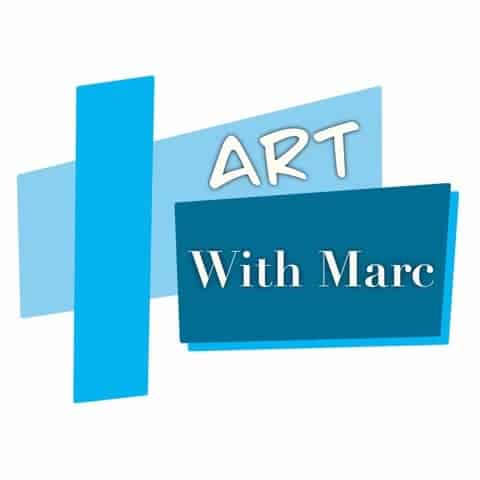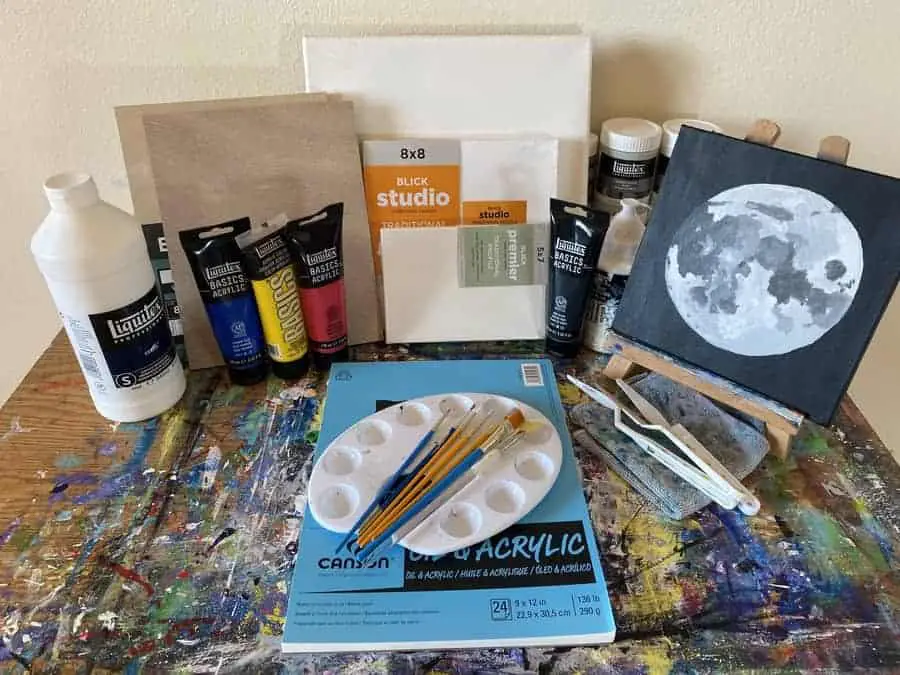
If you have recently decided that you want to start painting with acrylic paints but aren’t sure where to start, I can remember a time when I was in your shoes not that long ago.
I’m going to do my best to tell you everything I wish I could have found when I first decided that I wanted to start painting.
Of course, the first place to start is by getting some painting supplies and deciding what you want to paint. Then paint that vision while paying attention to the issues you encounter so that you can work on those next.
When first shopping for supplies it can be a bit confusing to know what to go with. I’m going to break down all your options and lay out some of the best options for you to choose from.
It really depends on your level of interest and what exactly you have in mind for what you want to do. That is if you have anything, in particular, you want to create already.
Whether that’s an acrylic pour, something abstract, or a beautiful sunset I can definitely help you to achieve that vision.
Once we cover supplies I want to tell you how to get started with your first painting. Even if you’ve never drawn or painted anything before you can paint something you will be proud of! I’m sure of it!
If you aren’t quite sure what you want to paint there are plenty of resources to follow along with as well. I have a few step by steps you can follow already and am working on a boatload more.
I can also point you in the direction of other artists online who have good free content or even paid courses that will help you along the way.
Beyond providing you with a step by step process when needed there is a specific mindset I seek to implant in your brain. One that has served me well so far and a way to make learning to paint or draw a more enjoyable process.
Acrylic Painting Supplies You Should Know About
To start with, we need to cover the various painting supplies you might potentially want to get.
Should you go with a paint set of some sort? Or is it better to create your own collection of paints and brushes?
What are the most basic fundamental brushes every artist should have in their first set of brushes? Should you get an easel?
How much should you spend?
Every artist’s journey is different. How we find answers to these questions that are suitable to fit you and your situation will depend on what your particular vision is.
Something drove you today to search for acrylic painting for beginners and click on this guide. Now that you’re here let’s take a look at the plethora of painting supplies there are to choose from and narrow it down to what will help you achieve that vision.
For this section, we are going to focus only on acrylic painting supplies.
We will discuss the importance of drawing on your journey a bit later. There we will cover a bit about drawing supplies.
For now let’s take a look at some different painting options for you to get started.
Related Pages:
- What Acrylic Paint Sealers Are and When To Use Them
- Canvas for Acrylic Painting: The Beginners Quick Reference Guide
- How To Clean Acrylic Paint Brushes While Painting
- Paper For Acrylic Painting (A CHEAP Alternative to Canvas!)
- Wood For Acrylic Painting: The Products You’re Looking For
Acrylic Paint Sets
First and foremost are the acrylic paint sets. These come in a variety of shapes, sizes, price ranges.
You can get them with everything you might need. Some of them don’t come with enough while others come with far too much in my opinion.
I actually started with a small acrylic paint set that only came with brushes. I wrote an article about paint sets with brushes you can check out by clicking here!
This isn’t a bad option as they are relatively inexpensive. If you go with one of these sets all you need then is canvases and an easel.
Other sets I have found come with both canvases and an easel. Something like the The Complete Acrylic Paint Kit – 54 Pieces – Keff Creations found on amazon comes with the exact things that I would recommend you have.
I have no idea the quality of the paint or other materials though. For all I know the easel might be garbage or there may be other issues with it.
That said, if your only intention is to just get anything so you can try your hand at painting it will serve its purpose and is currently under $70.
Once you get started you may get bit by the bug and starte collecting all kinds of supplies. All that matters is you find a way to start!
Common Beginner Acrylic Paint To Use
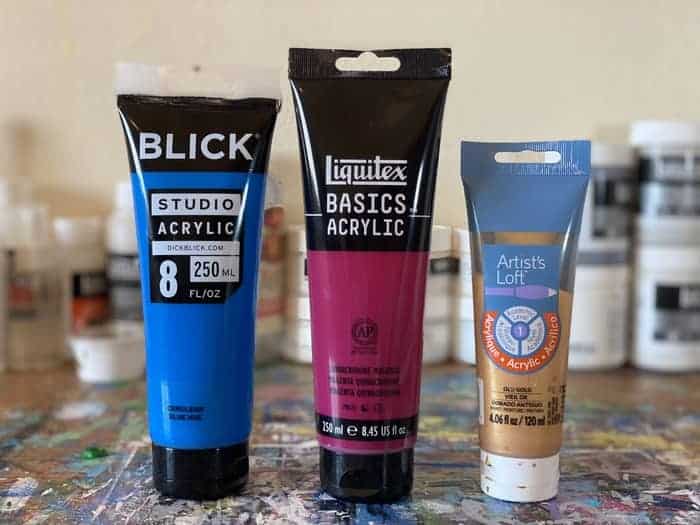
When you first start painting you may quickly notice that one of the most popular brands of acrylic paint out there is the Liquitex brand.
Most of my painting products are made by Liquitex and it has been the most readily accessible brand other than Artist’s loft.
These are the two main brands you will find in stores like Michael’s and Hobby Lobby.
Since shopping at DickBlick though I have recently started trying some of their brands of paint and I really love the colors in them.
I can’t quite put my finger on the differences between them but there is something about the hue and saturation of the DickBlick brand that I find more appealing.
I’ve only tried a few of the Artist’s loft brand so far too.
There are a lot of other quality brands to choose from but in way of quality paints for students these 3 brands are a great place to start!
We’re already going to cover so much more I have to keep it simple for now.
Acrylic Paint Brushes for Beginners
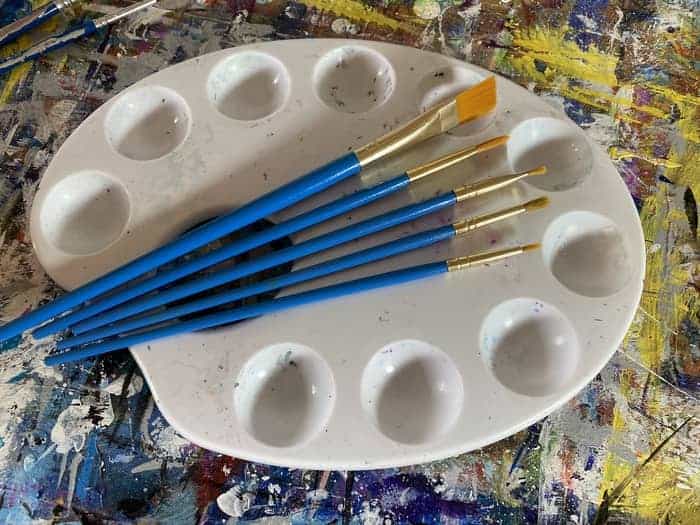
There are a lot of different types of acrylic paint brushes to cover. When it comes to your first brushes any set will do.
That said there are natural hair acrylic paint brushes and synthetic hair
What you see in the picture above is a standard beginner set of paintbrushes. One thing I might recommend is a few extra square-headed brushes like the large one you see but smaller than that.
Maybe it’s just me but I end up using them for a lot of different things.
In fact there is actually a really great paint brush set that I think would be really great for a beginner. This set of 6 Blick Golden Nylon Brushes found on DickBlick comes with several sizes of flat brushes.
Its description says it has Bright brushes in sizes 6 and 12 and Flat brushes in sizes of 1/4″ and 1/2″. This is why it might help to learn the names at some point.
I honestly would have seen all four of these brushes as flat or square headed brushes. Now it makes me wonder if the term square headed is suitable to even use or is that a different type of brush too?
As you can see I’m still trying to figure it out myself.
The names are irrelevant. You just need something to get started.
Over on DickBlick are a whole bunch of acrylic paint brush set to choose from. Check them out here!
As you progress you will want to expand your collection as some brushes make it very easy to get a particular effect.
Like the large oval brushes that Peter Dranitsen uses in this video below. You can see it here in the thumbnail but you can also check out what kind of effect he gets with it.
As you progress on your journey you will discover the need for certain tools. Take it one step at a time. Pick them up as you need them.
You don’t need to go overboard and drown yourself in too much stuff.
There is a certain feeling of progress we feel just by getting stuff to use. It is however easy to fall victim to equipment acquisition where you get the feeling of progress from buying things and then never actually learn to use them.
Don’t be that person. Just get what you need to get started with what you want to make now.
Canvases, Wood, or Paper? Which Should You Choose?
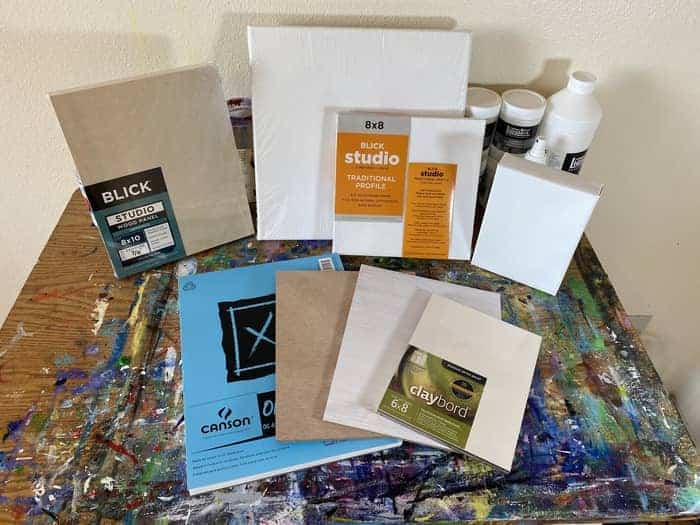
When it comes to what you can paint on the number of items is nearly infinite once you know what you’re doing. There are some limitations of course but for this section we will simply focus just on the more common ones.
My personal preference and what I like to recommend to anyone just getting started is the canvas. For more detailed information on all the various canvases for acrylic painting check out this page I wrote here!
When I say use canvas I mean stretched canvas. This is the type of canvas that is stretched around a wooden frame
It’s basically ready to hang on the wall as is once you finish your painting. This is the main reason I like to recommend it.
Putting my own work somewhere that I can enjoy it when it’s complete is one of my favorite parts of painting. For a newbie it will give you a sense of accomplishment and help motivate you to keep going.
I know it did me.
Okay, now let me get down from my soap box and tell you about the other options.
The main alternative a lot of beginners go with is acrylic painting paper as it is slightly cheaper. This Canson XL Oil and Acrylic Pad I got over at DickBlick was $14.60 when I bought it.
Which means each sheet costs roughly $1.70. So pretty affordable.
There are a lot of other acrylic painting pads to choose from. Check out this page I wrote on paper for acrylic painting here! There are a bunch of tables breaking down costs for you.
You don’t really want to use something not designed for acrylic paints but there are some cases where it makes sense. Check out that post for more details.
The next most common painting surface you may be interested in picking up is wood.
They come in flat panels or cradles. A cradle is basically a wooden frame that will allow you to hang it more easily just like a stretched canvas.
It does take a bit more work to properly prepare it for paint but there are reasons for going with it over a canvas. For more information on wood for acrylic painting check out this article over here.
Easels, Palettes and Palette Knives For Beginners
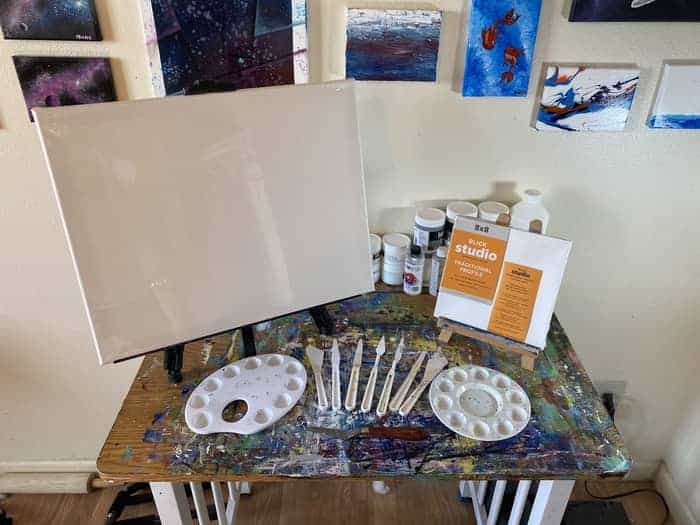
If you’re going to be working with stretched canvas it will definitely be useful to have some sort of easel.
If you’re planning on starting with small pieces then a table top easel will make do for a while.
If you’re going to be using some acrylic painting paper or mixed media pad then you can skip getting an easel for now.
People usually tape down sheets of paper onto the table. This has the added effect of leaving a nice white border around the painting when you’re done.
I’m wary of doing this as I learned in a drawing course by Brent Evinston I took on Skillshare, which you can find here, that you want to make sure your eyes are perpendicular to the drawing surface.
When they are not you see what you are drawing in a distorted way and it can cause it to become warped. This is why draftsmen’s desks are angled.
That said, I do work like this a lot. Especially when doing abstract paintings.
As for palettes, a small palette like one of these you see here would work just fine. I like the larger one more as it provides me with more space to mix my paints.
They are both quite common, very cheap, and easy to find. If you buy a kid of some sort it likely will come with one.
They usually also come with palette knives. Palette knives are great to have for a lot of reasons.
First off, I’ve collected a bunch of great palette knife artists and examples of their work for you to see the various ways that palette knives can be used.
Other than using them to create paintings with the also come in handy for mixing up your paints. Whether that’s mixing different paint colors together, mixing paint into a medium, or even mixing paint into texture pastes you will be using your palette knives to mix something at some point.
You can get a cheap set of 5 plastic knives from DickBlick here! This the set I have and they have done the trick so far.
Other Acrylic Painting Supplies
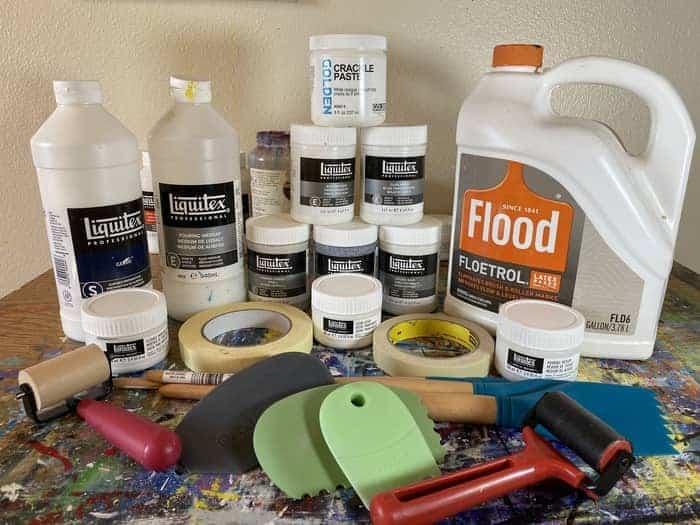
There are other supplies you may be interested in getting at some point but aren’t totally necessary for someone just getting started to have.
I’ll just touch on them briefly so you are aware of them for when you are ready to get them.
First off, there is this thing called Gesso. It’s basically a sealer and a primer. It is more of a primer than a sealer but it can be used to seal some things so that you can paint them without the paint getting absorbed as much.
It can also be used to texture a surface or even to smooth out a surface. So if you don’t like the grittiness of the canvas showing through your paint you could put down a few layers of gesso to help smooth out the surface.
Masking tape is another great tool to have at your disposal. It can be used to create sharp edges, drop shadows , and even cool borders around the edges of your cavnas.
The technique itself is called masking which is something that can also be done with stencils. It’s a common feature in digital programs too.
There are tons of paint mediums and texture pastes to explore too.
Paint mediums are used for a variety of things. You can get mediums to make your paint more fluid, more pearlescent, more iridescent, or even more slow drying.
One thing you can use mediums for is for acrylic pouring. There are a lot of people who get interested in making some art from seeing a cool acrylic pouring video.
To sum up mediums, they are about adding some desirable characteristics to your paint so you can work with it better or get a certain type of result.
There are a lot of different types of abstract tools you can look at collecting.
From tools designed specifically to be used in abstract painting to random things you will end up collecting along the way. The list is only limited by your own imagination.
Some tools specifically designed for painting that can be great to get are Princeton’s lineup of catalyst wedges, blades, and mini blades found over on the DickBlick website here.
These are the ones in my collection. I haven’t even used them yet. I’m going to have to create a project soon dedicated to how to use a catalyst wedge so I can take advantage of them and learn how to use them.
Other than catalyst wedges, there are rollers of various sizes and materials. They come in hard rubber, soft rubber, and sponges.
All of them will yield a different sort of textured effect. Especially if your sponges look like these ones!
Going just a bit further, there are acrylic paint pens as well. These are really great to have in your arsenal at some point. For more details on them check out this page I wrote here!
Related Articles:
- Abstract Acrylic Painting Techniques: Tools & Techniques For Beginners
- 6 Acrylic Paint Sets With Brushes (Paint Sets To Get You Started!)
- Acrylic Paint Pens and Markers: What Can You Use Them For?
- What Can You Use Acrylic Paint On? 13 Surfaces To Paint On!
- How To Use Acrylic Paint On Wood: Prepping to Paint
The Minimum Supplies Needed for Acrylic Painting
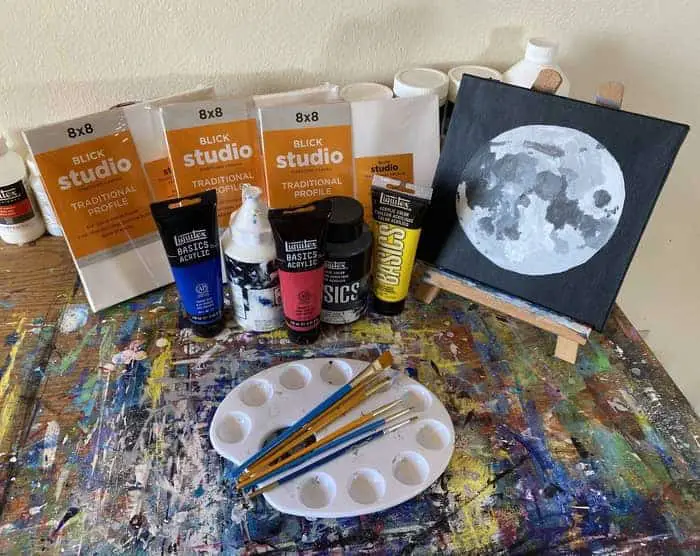
With all of that covered, what is the bare minimum you need to order or get in order to get started?
All you really need to get started is:
- A Set Of Brushes
- A Palette Knife Set
- A Set Of Basic Paints (At Least 5 Basic Colors)
- Canvases
- Tabletop Easel (Optional)
If you are interested in doing abstract art you may not need the easel. I rarely use an easel when painting abstractly.
You can work flat on a table like what you might see a lot of artists doing on YouTube.
If you are however actually going to be attempting to paint things like landscapes, people, or objects then you will want an easel to help prevent unwanted distortions.
Getting Started With Your First Painting

At this point, if you haven’t already purchased your supplies you have a good idea of what you need to get.
Now, if you could just figure out what to paint…
If you’re having trouble there, no worries, I got you! Not only do I have a number of step by steps available on this site already but I want to provide you with a few key things that have gotten me this far in less than 2 years.
Unfortunately at the time of writing this, I have been adding so much content to the site recently that the navigation is currently a mess. I don’t have any sort of hub yet that has all of the step by steps in one place.
So for now I put a list of all of my current how to’s at the bottom of this section and the rest at the bottom of this page.
Before you get started I have a few guiding principles that I’d like to impart on you.
First and foremost, I’m all about those bite size pieces and building confidence early on with easy wins. This is a principle used quite effectively in game design.
It’s all about increasing the amount of difficulty gradually.
So for your first painting choose something that looks super easy for you to do. You need to be able to get the gratification of completing your objective.
Just a little shot of dopamine for your brain will get you hooked.
The next thing you need to do is paint consciously. Be consciously aware of when you encounter something you need to learn more about or have trouble with.
I usually notate this mentally but if you need to write it down. Having trouble blending? Make sure you look up blending techniques before you start your next painting.
Let one thing lead to the next.
Research and then apply what you learn. Make each painting about learning something specific.
For your very first painting you’re likely not going to know what that is but I promise you, once you put that brush to your canvas something will come up.
Listen to that thought or frustration. Pursue it and overcome it. Study color theory when you need to know more about it. Study anatomy when you need to know more about it.
Until then, don’t worry about it. Just try to stay on the pathway of being consciously aware of what you are doing.
If you take this approach your learning process will be far more fluid and enjoyable. It may perhaps even be faster.
The time to mastery is cut in half if you can get into and maintain a flow state.
Easy Projects To Help You Get Started
- How To Paint A Galaxy (Easy Step By Step Guide)
- How To Paint A Moon Suspended In Space In 8 Easy Steps
- How To Paint a Campfire With a Soft Glow
- How To Paint a Rose Abstract Style (Easy Step by Step)
- Abstract Art Projects To Try
Keeping Your Brushes In Good Condition

When I first started painting I ruined quite a few brushes as I didn’t have great habits yet.
This is one thing that makes a cheap kit a good idea when you are first getting started. They don’t always come with the best quality brushes and you’re likely to forget to clean one at one point or maybe even not clean it properly causing it to become ruined.
Just keep in mind when you do your first painting that if you use more than one brush, keep the one you are not currently using wet. Especially if it still has any paint in it.
You really don’t want to leave it with paint in it though. If your not using it wash it off really good and then wipe it off. Then be sure to keep it damp if you intend to come back to it in a bit.
Once you are done painting wash your brushes immediately. Don’t get distracted trying to post it to Instagram before you clean up. For more insight on how to properly clean your brush I wrote a page on how to clean acrylic paint brushes here.
One other key thing is that once you do clean your brush be sure to dry it horizontally. If you’re curious as to why check out the link above to the other page I wrote on it.
What To Do When You Complete Your First Painting
The first thing I would advise doing is getting in the habit of signing and dating your works. You may not always want to do it on the front of the painting but it’s always a good idea to do somewhere.
This helps determine when in your development it was created. To me this is the most important part as I want to know that I’m getting better so I need to know what year of my art journey I created it in.
Another way to document your journey is to start an art Instagram from day one. Document your progress there by posting pictures of your work.
Even if you never get any sort of following just using it to keep a record of your work is worth it. Every post is dated so you will know when it was you completed it if you post a picture of every completed work.
After that, you may want to consider coming up with a name for it. Artists that end up selling their works will need to title their works. It’s just part of the game.
So it’s best to start practicing now if you desire to potentially get to that level someday. I am terrible about this one myself. I need to work on that.
It is of course up to you whether or not you want to do any of these things with your first painting. Which is ultimately the same thing for sealing it.
Sealing your painting to protect it from sunlight causing them to fade over time isn’t really necessary when you’re just getting started.
It’s good to know about though because as you get more serious you may want to start doing this to finish your paintings out.
Finally, what came up during the course of your first painting that you want to try to learn next?
Go study that a bit and then try a project that puts that knowledge to the test. Rinse and repeat.
Related Pages:
- What Acrylic Paint Sealers Are and When To Use Them
- Should I Start An Art Instagram?
- Starting An Art YouTube Channel
How Drawing Will Enhance Your Development

I know once I picked up painting I had sort of had an attitude about drawing.
When I made art as a teenager I had a preference for drawing and sketching. Once I picked up art again as an adult and found myself getting pulled in by the acrylic world I initially resisted picking up drawing too because I felt I had been there and done that.
Even though I had never come anywhere close to mastering it.
Eventually, I came to the realization that a drawing pad and pencil set are cheap and easy ways to practice developing my art skills anywhere and anytime.
Building up your visual library by drawing random things you might encounter as you go about your business or actually making time to go out in nature to do some life drawing.
Learning to draw will go a long way towards developing your painting skills further.
If you’re interested in picking up drawing as well there is a nice selection of sketch pads here on Dickblick.com.
I still have a few sketchbooks I need to fill up before I can try any of those options out for you.
As for pencils, again the pencils I have are just a small cheap set from Michael’s. You could do that yourself but I’m sure DickBlick has some better options here.
Related Pages:
- How To Start Drawing As A Hobby
- How To Draw Everyday: Developing a Daily Sketchbook habit
- How To Get Started Animating Today!
- Understanding The 12 Principles of Animation
- Affordable Drawing Tablets for Digital Art and Animation
Easy Projects For You To Try
While I don’t currently have a page with all of my current step by step projects on it I figured I would make a quick guide right here for you to help you get started.
- How to Paint Bubbles (An Easy Acrylic Painting Project!)
- How To Paint Clouds: A Step By Step Exploration Of Cloud Painting
- How To Paint Water (A Step By Step Guide)
- How To Paint a Sunset in 8 Easy Steps (Beginner Acrylic Painting)
- Silhouette Painting for Beginners
- Painting Planets With Acrylics
- How to Paint a Galaxy on a Canvas
- How To Do an Acrylic Pour
These are all the step by step/how to’s that I currently have at the time of writing this article.
There is a ton more content on this site to check out and I hope that you find it helpful on your journey!
